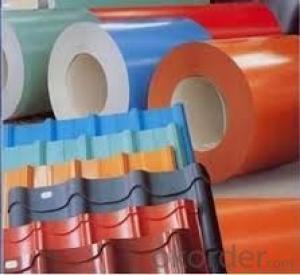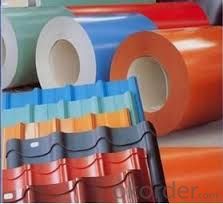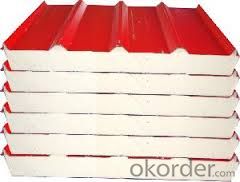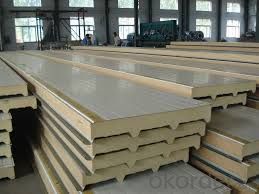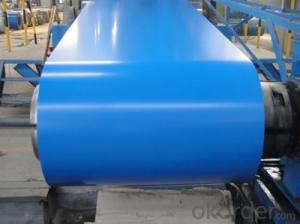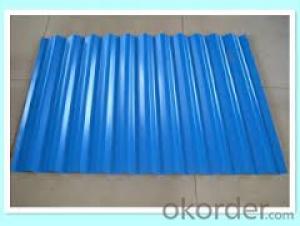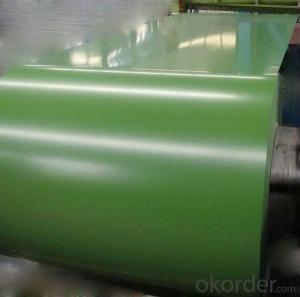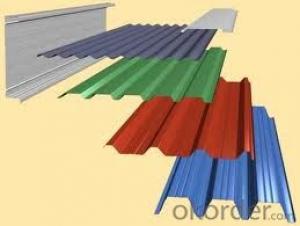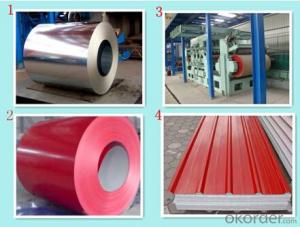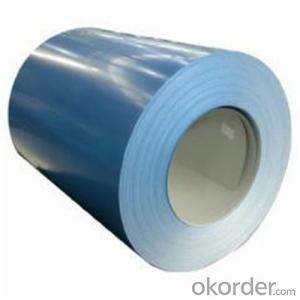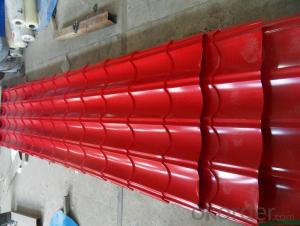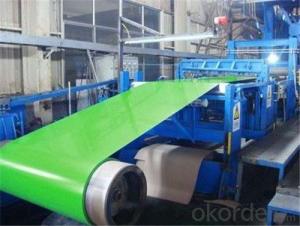Pre-Painted Galvanized Steel Coil/Construction Purposes, for Roofing
- Loading Port:
- Shanghai
- Payment Terms:
- TT OR LC
- Min Order Qty:
- 25 m.t.
- Supply Capability:
- 10000 m.t./month
OKorder Service Pledge
OKorder Financial Service
You Might Also Like
Product Description
Product Name: China PPGI manufacturer/PPGI MILL
PPGI coils
PPGI steel coils
PPGI galvanized coils
PPGI zinc coated coils
Pre-painted galvanized steel coils
Color coated steel coils
Color coated steel coils
Red color/blue color steel coils
Color coated PPGI FOR metal roof
DX51D color coated corten steel coil(PPGI)
Prime prepainted galvanized steel coil
White color prepainted steel coils
Color steel coil for roofing material
Dx51d+z prepainted steel coil
Colorful galvanized steel coil
Specifications:
Grades: Q195-Q235 and SPCC, SPCD, SPCE, SGCC (DX51D+Z) and SGCD (DX52D+Z)
Thickness: 0.13 to 2.0mm
Width: 600 to 1200mm or customized
Coil inner diameter: 508 to 610mm
Coil weight: Customized
Color: RAL
Surface protection: PE, PVDF, SMP and HDP
Surface treatment: Chromate, oil/un-oil, bright finish, spangle and anti-finger print
Standards: JIS G3302, JIS G3312 and ASTM A653M/A924M 1998
Zinc coating weight: 60 to 275G/M
Features:
Nice corrosion-resistant: Zinc layer provides nice protection of pre-painted galvanized steel sheet
High heat resistant: Reflective surface of material aids in efficiently reflecting sunlight away and turn reducing amount of heat transmitted, thermal reflectivity converts into energy-saving.
Coating adhesive force of color-coated sheet is strong, which keeps color and luster novel for long.
Widely used in such field as architecture, electrical home appliances, furniture, communal facilities, communications and transportation.
PPGI prepainted sheets and coils
Product thickness: 0.135 to 2.0mm
Product width: 760 to 1250mm
Coil weight: 5 to 10 metric tons
Coil ID: 508mm
Coil OD: Max 1500mm
Coating type: PE
Standards: JIS G 3312, ASTM A755M, GB/T 12754, Q/CHG 2-2003, EN 10143, DIN 17162
Material: TDC51D, AZ150, SGCC, CGCC, SPCC195L, TSGCC, CCGI, Q195-Q235, SPCD, SPCE
Color: RAL
Zinc coating: 60 to 275G/M²
Application: Construction, hardware, home appliances, interior decoration and more.
NAME | PPGI | GALVANIZED | GALVALUME/ALUZINC |
CERTIFICATE | ISO9001:2008 | ||
| EN10142 | ASTM A653 | ASTM A792 |
| CGCC | SS GRADE33-80 | GRADE33-80 |
MODEL NO | 0.16MM-1.5MM*1250MM OR UNDER | (0.12-1.5)*1250MM OR UNDER | 0.16MM-1.5MM*1250MM OR UNDER |
| Steel coil | Steel coil | Steel coil |
| Hot rolled-cold rolled | Hot rolled-cold rolled | Hot rolled-cold rolled |
SURFACE | Mini/regular/big/zero spangle, | Mini/regular/big/zero spangle, | |
APPLICATION | Structural use ,roofing, commercial use, household appliance, industry, family | ||
SPECIAL | Wear resistant steel, high- strength - steel plate | ||
- Q: What are the different methods of punching steel coils?
- For punching steel coils, there are several methods available that vary depending on specific requirements and desired outcomes. The following are some commonly used methods: 1. Mechanical Punching: To create holes in the steel coil, a mechanical press is employed. This method involves utilizing a punch and die set, where the coil is subjected to force from the punch to create the hole. Mechanical punching is best suited for small to medium-sized holes and finds frequent use in high-volume production settings. 2. Hydraulic Punching: In hydraulic punching, hydraulic pressure is utilized to drive the punch into the steel coil. This method is commonly employed for punching larger holes or shapes that demand greater force. Hydraulic punching machines offer precise control and can handle thicker and harder materials. 3. Laser Cutting: Laser cutting is a non-contact technique that employs a laser beam to cut through the steel coil. By directing a focused laser beam onto the coil, the material is melted and evaporated to form the desired shape or hole. Laser cutting provides high precision and can be used for complex shapes and patterns. 4. Plasma Cutting: Plasma cutting involves the use of a high-velocity jet of ionized gas (plasma) to melt and remove the steel coil material. This method is suitable for cutting thicker steel coils and is often employed for larger holes or irregular shapes. 5. Waterjet Cutting: Waterjet cutting uses a high-pressure jet of water mixed with abrasive particles to cut through the steel coil. This method is versatile and can effectively cut various materials, including steel. Waterjet cutting is renowned for its high precision and clean cuts. Each method of punching steel coils possesses its own advantages and considerations. Factors such as material thickness, desired precision, production volume, and cost will determine the most suitable method for a specific application.
- Q: How are steel coils used in the production of aerospace parts?
- Due to their strength, durability, and versatility, steel coils find extensive use in the aerospace industry for the production of aerospace parts. Made from high-quality carbon steel, these coils are formed into a coil shape, facilitating their transportation and storage. In the aerospace sector, steel coils play a crucial role in manufacturing different components, including structural parts, engine parts, landing gear, and fasteners. Specifically, steel coils are extensively employed in the fabrication of aircraft frames and fuselage structures. These coils are often cut, shaped, and welded to create the necessary structural components, which contribute to the aircraft's strength and stability. Another significant application of steel coils in aerospace production is the manufacturing of engine parts. Complex shapes are formed from the processed steel coils to produce components like turbine blades, shafts, and casings. These components must withstand high temperatures, pressure, and stress, and steel coils possess the requisite strength and heat resistance for such demanding applications. Furthermore, steel coils find utility in the production of landing gear, which supports the aircraft during takeoff, landing, and ground operations. The processed steel coils are shaped into various parts of the landing gear system, including struts, beams, and brackets. These components undergo rigorous testing and require excellent strength, toughness, and fatigue resistance, all of which are provided by steel coils. Additionally, steel coils are commonly employed in the manufacturing of fasteners essential for aerospace applications. Bolts, screws, and rivets play a crucial role in joining different components together, ensuring structural integrity and safety. Steel coils are processed and formed into the desired shapes for these fasteners, offering the necessary strength and reliability for these critical connections. In summary, steel coils are indispensable in the production of aerospace parts due to their exceptional mechanical properties and reliability. Their versatility enables various shaping and processing techniques, allowing for the creation of complex and high-performance components. By incorporating steel coils into aerospace manufacturing, the industry can ensure the production of durable, safe, and efficient aircraft.
- Q: How are steel coils used in the manufacturing of pipes?
- Steel coils are used in the manufacturing of pipes as they provide the raw material needed for pipe production. The coils are uncoiled and then passed through a series of machines, where they are shaped, welded, and cut to the desired length and diameter. This process allows for efficient and precise pipe manufacturing, ensuring the strength and durability of the final product.
- Q: So here's the deal:I recently bought McCann's Instant Steel-Cut Oatmeal, and I'm wondering about any possible nutritional differences between the instant and regular stove-top. In case you haven't seen it, instant steel-cut comes in individual packets and is cooked only by adding boiling water, the same as instant rolled oatmeal (i.e. Quaker).When I asked about instant vs. stove-top rolled oats, my doctor said there are no significant nutritional differences, but since the main health appeal of steel-cut is the coarse grain, it doesn't seem possible for the finer ground instant to be as nutritious.I can't find much info about this, so any help is appreciated!
- The rationale for consuming steel cut oats rather than rolled oats (beyond the fact that the former taste really good) is the lower glycemic index. It is my understanding that in the rolled oat category, it is better to eat the long-cooking variety rather the instant for the improved fiber load and lower glycemic index. While I do not understand exactly how instant steel cut oats are processed and how much the glycemic index is affected by processing, it is safe to assume that the old unprocessed steel cut oats are still best. I always prepare 4-6 servings of the steel cut oats at one time and warm up a serving when needed to avoid having to wait 30 minutes to cook them. My rule of thumb: the less processing for any food product, the better it is for me.
- Q: What is the average lifespan of a steel coil storage rack?
- The average lifespan of a steel coil storage rack can vary depending on various factors such as the quality of the rack, the frequency and intensity of use, and proper maintenance. However, a well-maintained and durable steel coil storage rack can typically last for several decades.
- Q: How do steel coils resist corrosion?
- A combination of factors contributes to the corrosion resistance of steel coils, including the presence of protective coatings, the utilization of corrosion-resistant alloys, and the implementation of proper handling and storage practices. Galvanization, which involves the application of zinc coatings, is the most common method employed to prevent corrosion in steel coils. This process establishes a barrier between the steel and its surroundings, effectively shielding it from moisture and corrosive elements. The zinc coating acts as a sacrificial layer, taking the brunt of the corrosion instead of the steel itself. Another approach to enhance corrosion resistance entails the use of corrosion-resistant alloys. These alloys are specifically designed to endure harsh conditions and are composed of elements like chromium, nickel, or molybdenum. Upon exposure to the environment, these alloys form a passive oxide layer on the surface of the steel, serving as a protective shield against corrosion. In addition, proper handling and storage practices are crucial in preventing corrosion. It is important to store steel coils in dry and well-ventilated areas to minimize contact with moisture. Care must also be taken to avoid contact with other metals and materials that could result in galvanic corrosion. Regular inspections and maintenance are essential for promptly identifying and addressing any signs of corrosion. In conclusion, the resistance of steel coils to corrosion is achieved through the implementation of protective coatings, the utilization of corrosion-resistant alloys, and the application of proper handling and storage practices. By employing these measures, the longevity and durability of steel coils are ensured in diverse environments.
- Q: How are steel coils inspected for surface finish variations?
- Steel coils are inspected for surface finish variations using visual inspection techniques, such as the use of specialized lighting and magnification to identify any imperfections or inconsistencies on the surface. Additionally, non-destructive testing methods, such as laser scanning or magnetic particle inspection, may be employed to detect any surface defects that are not visible to the naked eye.
- Q: How are steel coils used in the production of metal storage systems?
- Steel coils are used in the production of metal storage systems as the primary raw material. These coils are processed and shaped into the desired forms, such as sheets, panels, or beams, which are then assembled to create sturdy and durable storage systems capable of safely storing various items.
- Q: I want an EDC (Every Day Carry) Knife that:~folds~is non-serrated~has a pocket clip~has a blade length of about 4 in. long~is concealable~urban environment friendly~priced around $50What do you suggest? I am currently thinking on purchasing the Cold Steel 4 inch Zytel Ti-Lite.
- Based okorder /
- Q: What material is strongest? Human bone, steel, or concrete?
- I guess I would ask you to define strong then? For example: make a bed and line it with steel, then lie down in it and have someone poor concrete on you. Let it dry overnight and then try and get out. What will break first? Could be anyone of these. If you had a watch made out of bone or concrete and it fell off, it too would break. There you have it amigo, define strong!
Send your message to us
Pre-Painted Galvanized Steel Coil/Construction Purposes, for Roofing
- Loading Port:
- Shanghai
- Payment Terms:
- TT OR LC
- Min Order Qty:
- 25 m.t.
- Supply Capability:
- 10000 m.t./month
OKorder Service Pledge
OKorder Financial Service
Similar products
Hot products
Hot Searches
Related keywords
